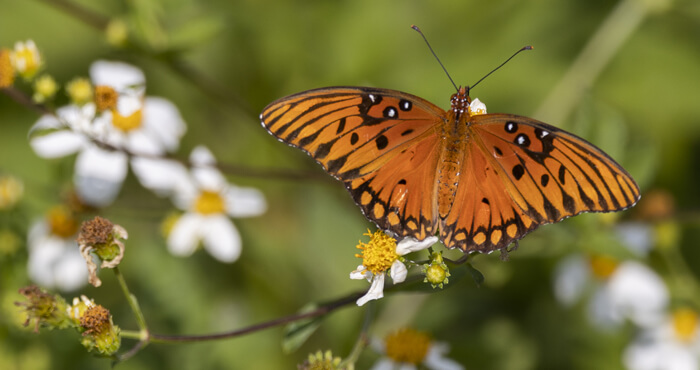
Pest Alert: Whiteflies
Whiteflies have long been considered a major pest of ornamental crops, and the problem may get worse.
History
Until 1986, the primary pest species of whitefly was the greenhouse whitefly, Trialeurodes vaporariorum. In 1985, Bemisia tabaci (Gennadius) was found attacking an variety of ornamental plants in Florida greenhouses. Scientists in Florida soon realized that this species was causing damage different from that previously attributed to whiteflies.
B-Biotype
Feeding by the B-biotype whitefly causes many plants to show signs of infestation. The plants change color, turning yellow, white, or silver, depending on the specific host plant. Because various squash species turn silver when infested with the B-biotype (also known as Bemisia argentifolii), this biotype was given the common name, "silverleaf whitefly."
Q-Biotype
In March 2005, the Q-biotype of Bemisia tabaci was detected in whiteflies collected from poinsettia in a retail outlet. These whiteflies had been collected in December 2004 as part of a pesticide resistance monitoring program in Arizona. Most of the samples had been from cotton and other crops. Poinsettia and ornamental crops were not the primary focus of this monitoring program. Other scientists independently verified the whitefly as the Q-biotype--the first time this particular strain had been found in the United States.
The Q-biotype is thought to have originated from the Mediterranean region and has been associated with whitefly control problems. It can be characterized as being virtually immune to the insect growth regulator pyriproxyfen (Distance), having strikingly reduced susceptibility to the IGR buprofezin (Talus), and having a reduced susceptibility to the neonicotinoids insecticides imidacloprid (Marathon or Merit), acetamiprid (TriStar) and thimethoxam (Flagship).
The information currently available was generated using laboratory bioassays, and no field efficacy work has been conducted to determine how these data relate to controlling the Q-biotype in the field in the United States. The Q-biotype has not been found outside of greenhouses. The Q-biotype is known to have resistance to pyriproxyfen and buprofezin, as well as reduced susceptibility to the neonicotinoid insecticides imidacloprid and acetamiprid in other regions of the world.
Description & Biology
The greenhouse and silverleaf whiteflies are the primary whitefly pests of greenhouse crops. Banded-winged and citrus whiteflies are also found in greenhouses but usually do not reproduce and develop damaging populations. Compared to other pests of ornamentals, whiteflies have a long life cycle, ranging from two-and-a-half to three weeks under warm conditions to two months under cooler conditions.
Adults are moth-like and covered with white, waxy powder. Adult female whiteflies are about 1/16 of an inch in length. They can deposit about fifty eggs in cool environments and up to four hundred eggs at higher temperatures. Consequently a whitefly population can reach very high levels in a few generations at higher temperatures.
Eggs are inserted on end upon a short stalk on the underside of leaves. Eggs are whitish to light beige but change to a dark blue or purple before hatching. The immature stages resemble miniature scale insects. They are flat and oval, glassy to opaque, light yellowish or greenish, and often provided with a fringe of wax filaments. Older immatures tend to be darker and either cream or yellow in color. Newly hatched immature crawlers move around on the leaf for only a few hours, then insert their mouthparts and begin to feed. The remainder of the immature development is sessile.
Whiteflies feed exclusively on leaves, nearly always occurring on the undersurface. They suck juices from the plants and also excrete large quantities of honeydew in which sooty mold grows.
Feeding Damage & Symptoms
Whiteflies feed on more than five hundred species of host plants. Greenhouse-grown ornamentals such as poinsettia, hibiscus, ivy, gerbera daisy, lantana, verbena, garden chrysanthemum, salvia, and mandevilla are especially susceptible to whitefly damage.
Whiteflies feed on plant phloem by injecting enzymes and removing the sap, reducing the vigor of the plant. Honeydew secretions from whiteflies promote the growth of sooty mold, which significantly reduces plant quality.
The most obvious whitefly feeding damage symptoms are stem blanching, chlorotic spots, leaf yellowing and shedding, and--at high population levels--plant death. In many crops, the damage caused by Bemisia tabaci is indirect, since this species of whitefly is responsible for transmitting many devastating viruses.
Detection & Sampling
You can monitor whitefly population levels by trapping winged adults on sticky cards and inspecting leaves for the presence of feeding immatures.
- To provide information about the presence and movement of whiteflies, strategically place yellow sticky cards throughout the greenhouse, especially near doors and among new plants.
- To detect whiteflies on plants, randomly select ten plants per thousand square feet of greenhouse space and--using a 10X hand lens--thoroughly examine the undersides of these plants' leaves for the presence of whitefly adults, nymphs and eggs.
Determination of biotypes is accomplished in the laboratory by using sophisticated biochemical techniques. Therefore, growers will have to send preserved whiteflies to one of the participating labs. (Contact your county Extension office for more information about these labs.) Currently, this pest is not rated as a pest with quarantine status, which means there are no legal requirements for these labs to report their findings.
Regardless of which whitefly biotype you have, it is prudent to monitor for whiteflies and develop a Resistance Management Program (RMP).
Management Methods
Chemical Control
Insecticides are the primary method used to control whiteflies. Many compounds have been used, but the systemic Marathon (imadacloprid) has been used most frequently over the past few years. The newer chemically related compounds Celero (clothianidin), Flagship (thiamethoxam), Safari (dinotefuran), and TriStar (acetamiprid) are also effective.
Endeavor (pymetrozine), Aria (flonicamid), and the insect growth regulator (IGR) Distance (pyriproxyfen) are new chemical classes that have activity as well. Several other effective IGRs are Azatin/Ornazin/AzaDirect (azadirachtin), Enstar II (kinoprene), Pedestal (novaluron), and Talus (buprofezin).
The newest material to be registered for whitefly control is Judo (spiromesifen). Tank mixes of a pyrethroid and orthene (acephate) are synergistic, providing better control than either orthese or pyrethroid used alone, but many populations are now resistant to such combinations. A few other general insecticides, aerosols, and soaps or oils can also be used.
The newly hatched crawlers and the adults are most susceptible to chemicals, but the waxy covering on the larger immatures makes them more difficult to cover thoroughly with spray material. Resistance is a major problem, and every effort should be made to rotate chemicals with each application. Do not rely on any one product or chemical class for whitefly control.
Biological Control
Several biological agents are available. These include predators (e.g., Orius, Delphastus, lacewing larvae), parasitoids (e.g., Eretmocerus, Encarsia), or pathogens (e.g., Beauveria bassiana). In Florida, Encaria sophia (formerly transvena) has been used to effectively manage Bemisia tabaci on ornamentals and vegetables grown in greenhouses. Check with suppliers for information about compatibility with chemicals and environmental requirements such as temperature, humidity, and daylength.
A couple of Florida's largest growers are producing their own insect pathogens to be used throughout the growing season in conjunction with other pesticides. Chemical and biological controls should be used in conjunction to combat whiteflies,, and this can be done economically.
Physical Control
Exclude whiteflies from the greenhouse. Whiteflies are very small. Screens with a hole size of less than 0.19mm are required to exclude adult whiteflies.
Be proactive; find them first. Scout greenhouses by using sticky cards, leaf inspections, or random sampling techniques. Use this information as a basis for decisions about chemical applications. Start any control practice early, when the first whiteflies are detected. Control is difficult once populations reach high levels.
Significant whitefly reduction has been achieved by treating whitefly infested cuttings and plants with insect pathogens just prior to boxing and shipping. Currently, there are no procedures for managing pests during transit or shipping of plants.
Scouting & Prevention
Don't panic! Growers that have the Q-biotype in other parts of the world are still producing crops. Go back to the basics and fine-tune your whitefly IPM program.
Scouting
Determine the extent of any whitefly problems. Make sure that your employees' training is up-to-date and that they are aware that not all whiteflies are the same. If any populations exist and the numbers--or even their presence--seems the least bit unusual, find out what type you have. Studies have shown that for populations with both Q- and B-biotypes, increasing pesticide applications only increases the the Q-biotype portion of the population.
Prevention
Do not let new whiteflies into your operation. You may not be able to prevent movement into your nursery from outside sources, but you can reduce your risk by inspecting new plant material in a secure place to prevent whiteflies from escaping. Quarantine all new plant material introduced into your nursery until it has been carefully inspected.
- SANITATION - Remove sources of infestation that might carry over populations from one season to the next.
- CULTURAL CONTROL - Grow plants so as to facilitate good pesticide coverage. If possible, have a crop-free period to break any cycling within your nursery.
- PHYSICAL CONTROL - Screening and weeding limit the accessibility of your crops.
Resistance Management
If no virus is involved in the system, then the ultimate goal is not zero whiteflies throughout the production cycle, but zero whiteflies on the plant material leaving the facility.
Resistance Development
Unfortunately, pesticide applications can strengthen the resistance of whiteflies to these products. Larger numbers of whiteflies increase the probability that at least one individual might posses the ability to survive the treatment. Frequent use of a given pesticide or mode of action also increases the potential for developing a problem, and longer residual activity increases selection pressure.
Older recommendations stated, "Insecticides should be applied a minimum of two times at a five- to seven-day interval to allow for egg hatch between applications so that both adults, nymphs, and individuals that hatch from eggs are killed." These guidelines are not appropriate for many of the new pesticides that have residual activity of one week or greater.
Changing Tactics
Due to the propensity of whitefly populations to develop resistance, it is essential to scout weekly and especially after a pesticide application. If an insecticide has been properly applied and is not providing control, do not hesitate to change to another material with a different mode of action. Growers must learn from experience which chemicals fail to give satisfactory control when correctly applied and be willing to try other materials in a different classification.
Often, severe pest problems occur on plants in the retail shop because a few eggs, nymphs, or adults survived even the best and most conscientiously followed control program during production. It is imperative, therefore, that you apply your most effective pesticide to major whitefly host plants as close to the date of shipment as possible.
Planning a Pest Management Program
Fewer applications of materials from a given class results in a reduced potential for resistance development.
- Develop a list of all the pesticides that are legal to use for whitefly control on your crops.
- Evaluate each of your crops for phytotoxicity. When you are finished, you will have a list from which you can develop a management program.
- Review labels for restrictions or limitations on how often a material can be applied to a given crop.
The plan you put together should be based on all of these points and the fact that growers will have to apply materials to manage other pests. Scouting is essential to the success of any pest management program.
Excerpted from:
Whiteflies, maintained by Lance Osborne.
RESOURCES
UF/IFAS Publications
- Agribusiness
- Agricultural Health and Safety
- Agronomy
- Crops
- Florida Forage Handbook
- Vegetables & Herbs
- Livestock and Poultry
- Nurseries and Greenhouses
- Florida Soil and Water - by County
- Sustainable Agriculture
- Weed Management in Field Crops and Pasture Grasses (WMG)
State & Federal Agencies
- Florida Department of Agriculture and Consumer Services (FDACS)
- Fish and Wildlife Research Institute—Florida Fish and Wildlife Conservation Commission
- Florida Department of Environmental Protection
- South Florida Information Access (SOFIA)—U.S. Geological Survey
- U.S. Department of Agriculture (USDA)
- U.S. Forest Service—USDA
- U.S. Environmental Protection Agency (EPA)
- U.S. Fish & Wildlife Service
- U.S. Geological Survey (USGS)



.jpg)

.jpg)